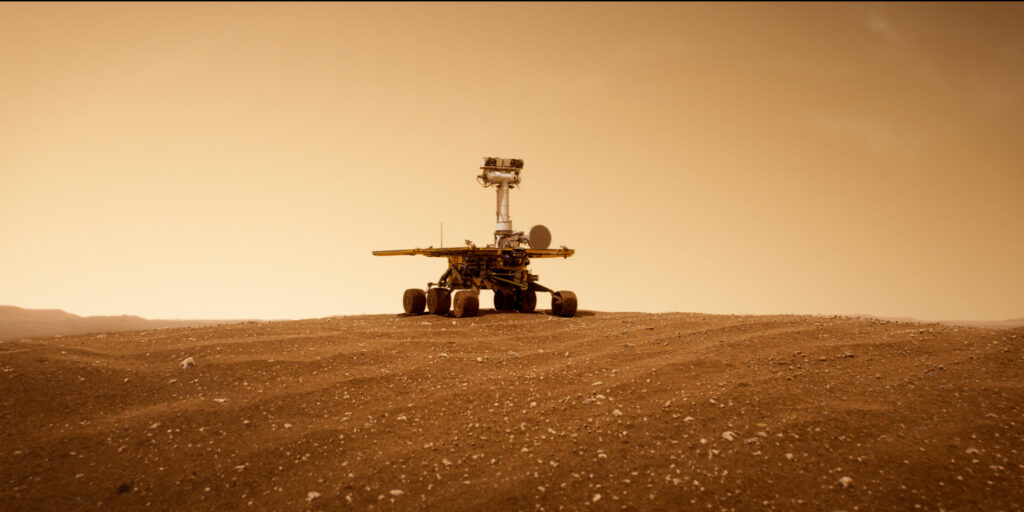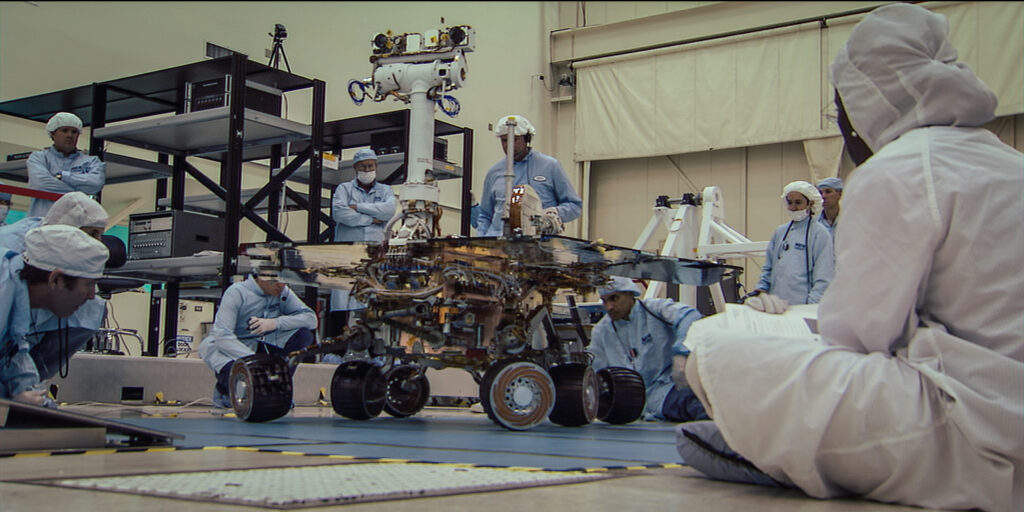November 12, 2022
by Carla Hay

Directed by Ryan White
Culture Representation: Taking place in California and Florida and on Mars, the documentary film “Good Night Oppy” features a predominantly white group of people (with some black people and one person of Indian heritage), who are current and former NASA employees, discussing the journey of two identical roving robots—one named Spirit, the other named Opportunity—that NASA sent on a mission to explore Mars, in a journey that began in 2004.
Culture Clash: Spirit had frequent technical problems and other obstacles, while Opportunity (nicknamed Oppy) survived and thrived much longer than most people expected.
Culture Audience: “Good Night Oppy” will appeal primarily to people who are interested in documentaries about space exploration and overcoming seemngly impossible odds.

“Good Night Oppy” informs, entertains, and gets people emotional about robot exploration on Mars. This impressive documentary is a perfect example of how science and technology are much more meaningful when they don’t lose their humanity. One of the best things about “Good Night Oppy” is that people don’t need to have any knowledge about outer-space exploration to enjoy the movie. People who don’t think they have any interest in this topic will probably be surprised by how engaging “Good Night Oppy” can be in telling this unique story.
Directed by Ryan White, “Good Night Oppy” had its world premiere at the 2022 Telluride Film Festival in Colorado. The documentary is told entirely from the perspectives of the NASA team members who were involved the journey of two physically identical robots named Spirit and Opportunity (nicknamed Oppy) that were sent to Mars (also known as “the red planet”) for an exploration mission. “Good Night Oppy” uses visual effects to recreate much of what Spirit and Opportunity saw and experienced on Mars. The movie also features many of the actual photos of Mars that the twins sent back to Earth, as well as archival footage of what was happening on Earth during this journey.
At first glance, it might seem like “Good Night Oppy” is a very one-sided documentary because it interviews only people connected to NASA (National Aeronautics and Space Administration). However, by the end of the movie, it’s obvious that it would have been a mistake for the “Good Night Oppy” filmmakers to overstuff the documentary with too many interviews of people who didn’t have direct knowledge of this history-making Mars exploration. The current and former NASA employees who tell this story have intimate details that no outside expert would be able to tell in such an informed way.
Even before this exploration of Mars began in January 2004, it was a long and often-frustrating road to get there. Steve Squryes, the principal scientist of the project, said that for about 10 years, beginning in the mid-1980s, NASA rejected his proposals about having robots explore Mars and doing things such as send images and other information about Mars back to Earth. When one of Squryes’ proposals was finally accepted, it took several more years for the robots to be designed and built up to NASA standards. Finally, the robots were ready to be sent to Mars in 2003.
Much of this work was done by NASA’s Mars Program at Jet Propulsion Laboratory in Pasadena, California. It’s explained in the documentary that an ideal window of opportunity to send a robotic rover to Mars comes along once every 26 months. Ashley Stroupe, a rover driver responsible for the movements of NASA’s rovers on Mars, comments: “The overall goal of the Mars program has been the question of, ‘Did Mars actually have life?'”
Two special robots named Spirit and Opportunity were about to find out and let people on Earth know what was discovered. Spirit and Opportunity are described as robotic rovers that were built as identical twins, but they ended having very different “personalities” and experiences on Mars. Both rovers were given the female gender when assigning their pronouns.
Each rover was 5’2″, which is the average height of a human being. But that’s as far as the similarities went to how much the rovers physically resembled human beings. Atshitey Trebi-Ollennu, a robotics engineer, explains in the documentary that the rovers’ arms were designed to have “multiple instruments to take measurements and microscopic images, like a Swiss Army knife.” Each rover also had six wheels for movement on the ground.
From the beginning, Spirit was the one who ran into the most problems. Spirit failed the first major test, while Opportunity passed the same test. As camera operations engineer Doug Ellison says in the documentary, “Even before they left this planet, Spirit was troublesome. Opportunity was Little Miss Perfect.”
Eventually, the twins were ready for their trip to Mars with their launch at Kennedy Space Center on Florida’s Merritt Island. Spirit launched on June 10, 2003, and landed on Mars on January 3, 2004. Opportunity launched on July 7, 2003, and landed on Mars on January 24, 2004.
Due to extreme weather conditions on Mars and any unforeseen events, the rovers were expected to last about 90 days on Mars. Spirit and Opportunity lasted much longer than 90 days. And one of them lasted even longer than most of the NASA scientists and engineers even thought was possible. (How long Spirit and Opportunity lasted will not be revealed in this review, so as not to spoil this information for people who don’t know and want to find out when watching “Good Night Oppy.”)
The documentary mentions that NASA’s Mars program team would make bets on if either, both or neither of the robots would still be functioning the following year. During every bet, Squyres admits he always pessimistically predicted that Spirit and Opportunity would not make it to the following year, in order to be prepared for this disappointment. But contrast, lead systems engineer Rob Manning says that he always optimistically predicted that Spirit and Opportunity would survive through the following year.
Spirit and Opportunity landed on two very different parts of Mars, affecting each rover’s journey. Spirit landed in Gusev Crater, experienced freezing temperatures that would kill any human being, and had several malfunctions and setbacks along the way. By contrast, Opportunity landed in a small crater in the Meridiani plains, she traveled in much more moderate temperatures, and she had malfunctions that were minor, compared to Spirit’s malfunctions.
Mission manager Jennifer Trosper quips in the documentary, “Oppy was at the equator, like the vacation spot of Mars.” Earlier in the documentary, Trosper comments on why people on Earth put so much effort into outer-space travel: “Something I think we all wonder about as we look up into the night sky is if we’re really alone in this universe. And trying to understand that is one of the great mysteries we have.”
One of the main priorities of this mission was to see if Mars had any evidence of water that would be drinkable to people on Earth. Spirit’s exploration found no evidence of water on Mars. By contrast, Opportunity found evidence that there used to be water on Mars, when hematite was seen in her landing space. It’s explained in the documentary that the water from hematite had qualities like battery acid, but it was still water nonetheless. Oppy would later make an even bigger discovery related to water on Mars.
In other words, Oppy became the “star” rover of this mission, but that didn’t mean that people inside and outside of NASA didn’t get emotionally attached to both rovers. There were nerve-wracking moments when the twins experienced the same problems at different times—signals that got lost, tornado-like winds that forced the mission control team to temporarily shut the rovers down to save on battery energy, and emergency reboots that were never guaranteed to work.
“Good Night Oppy” gives a riveting behind-the-scenes look at the anxiety, joy, fear, sadness and hope that went into this mission. The movie also shows and tells in easy-to-understand details how Spirit and Opportunity were controlled by the team on Earth, and how these two rovers were given autonomy to make their own decisions.
Vandi Verma, one of the rover drivers, explains what was like to operate a rover: “It’s not like regular driving, because it takes four to 20 minutes for a signal to reach Mars. We send the commands, we go off and sleep. And the rover will execute the drive that day. And by the time the drive is done, we come back and get the results and start the planning.”
Spirit and Opportunity also had “diaries” during their journey, which are intermittently narrated in “Good Night Oppy” by Angela Bassett. The narration gives a very calm and authoritative human voice to the thought processes and actions of rovers that weren’t humans but who acted like living beings capable of making their own decisions. It’s no wonder that people got so emotionally attached to Spirit and Opportunity.
Ellison comments, “Yeah, it’s a robot, but through this robot, we’re on this incredible adventure together, and she becomes a family member.” Squyres describes how he felt when the robots he dreamed about and planned for all those years were finally completed and ready to go to Mars: “To say it’s like a child being born is to trivialize parenthood, but it sort of feels like that.” Mechanical engineer Kobie Boykins comes right out and says that Spirit and Opportunity were like his “babies,” and when they went to Mars, it was similar to how a parent feels when a child grows up and leaves home to live somewhere else.
“Good Night Oppy” does a very good job of giving the interviews a personal touch, by letting each person interviewed talk a little bit about how and why they became passionate about outer-space exploration. Boykins mentions that when he was a kid, “Star Trek: The Next Generation” character Geordi La Forge (played by LeVar Burton) was a huge inspiration for him. Trosper’s father used to work on space missiles, and she credits him with encouraging her to pursue her dream of having a NASA career at a time when many girls and women were told that technology-related work at NASA was a man’s job. Trebi-Ollennu, who is originally from Ghana, talks about his earliest memory of being interested in engineering came from his childhood, when he was fascinated by how a radio works.
Planetary protection engineer Moogega Cooper says that when she was a child, she entered NASA’s contest to name the twin rovers before the rovers were sent to Mars. She chose the names Romulus and Remus, the twin sons of the god Mars from Roman mythology. Deputy project scientist Abigail Freeman was one of the 16 high school students from around the world who were chosen to be in the mission control room when Oppy’s first images of Mars were sent to Earth. Years, later Freeman would be working in NASA’s Mars program as a scientist.
Some of the interviewees talk about the parallels between what Spirit and Opportunity experienced and what was going on in their own personal lives. Verma says that she was pregnant with twins during part of the time that she spent as a rover driver during the mission. Flight director Bekah Sosland-Siegfriedt, who says that Opportunity was the reason why she wanted to become a space engineer, shares a poignant story of how her grandmother was living with Alzheimer’s disease at the same time that Opportunity was getting older and losing her memory.
In addition to having stunning visual images and heartfelt stories, “Good Night Oppy” makes excellent use of music, with an emotionally stirring score by Blake Neely and some well-chosen soundtrack song choices. One of the rituals during the mission was a morning wakeup song that usually fit the plan (or intended plan) of the day. Songs like The B-52’s “Roam,” ABBA’s “S.O.S.” and Billie Holiday’s “I’ll Be Seeing You” are featured prominently in some of the documentary’s pivotal scenes.
“Good Night Oppy” has all of the elements of a better-than-average documentary and excels in areas where similar documentaries might stumble. “Good Night Oppy” can educate people without being a boring or condescending lecture. It tells a story that involves some of the highest levels of science, but they’re described in ways that people of many different backgrounds and ages can relate to and understand. And, most importantly, “Good Night Oppy” shows that inspiration, camaraderie and possibilities can have no borders and can extend well beyond planet Earth.
Amazon Studios released “Good Night Oppy” in select U.S. cinemas on November 4, 2022. Prime Video will premiere the movie on November 23, 2022.
